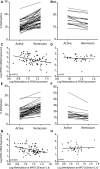Gene-Specific DNA Methylation Changes Predict Remission in Patients with ANCA-Associated Vasculitis
- PMID: 27821628
- PMCID: PMC5373455
- DOI: 10.1681/ASN.2016050548
Gene-Specific DNA Methylation Changes Predict Remission in Patients with ANCA-Associated Vasculitis
Abstract
ANCA-associated vasculitis is an autoimmune condition characterized by vascular inflammation and organ damage. Pharmacologically induced remission of this condition is complicated by relapses. Potential triggers of relapse are immunologic challenges and environmental insults, both of which associate with changes in epigenetic silencing modifications. Altered histone modifications implicated in gene silencing associate with aberrant autoantigen expression. To establish a link between DNA methylation, a model epigenetic gene silencing modification, and autoantigen gene expression and disease status in ANCA-associated vasculitis, we measured gene-specific DNA methylation of the autoantigen genes myeloperoxidase (MPO) and proteinase 3 (PRTN3) in leukocytes of patients with ANCA-associated vasculitis observed longitudinally (n=82) and of healthy controls (n=32). Patients with active disease demonstrated hypomethylation of MPO and PRTN3 and increased expression of the autoantigens; in remission, DNA methylation generally increased. Longitudinal analysis revealed that patients with ANCA-associated vasculitis could be divided into two groups, on the basis of whether DNA methylation increased or decreased from active disease to remission. In patients with increased DNA methylation, MPO and PRTN3 expression correlated with DNA methylation. Kaplan-Meier estimate of relapse revealed patients with increased DNA methylation at the PRTN3 promoter had a significantly greater probability of a relapse-free period (P<0.001), independent of ANCA serotype. Patients with decreased DNA methylation at the PRTN3 promoter had a greater risk of relapse (hazard ratio, 4.55; 95% confidence interval, 2.09 to 9.91). Thus, changes in the DNA methylation status of the PRTN3 promoter may predict the likelihood of stable remission and explain autoantigen gene regulation.
Keywords: ANCA; DNA methylation; epigenetics; gene expression; vasculitis.
Copyright © 2017 by the American Society of Nephrology.
Figures





Comment in
-
Epigenetic Modifications in ANCA-Associated Vasculitis: Potential for Insights into Disease Pathogenesis and Prediction of Outcome?J Am Soc Nephrol. 2017 Apr;28(4):1011-1013. doi: 10.1681/ASN.2016111260. Epub 2017 Jan 3. J Am Soc Nephrol. 2017. PMID: 28049651 Free PMC article. No abstract available.
References
-
- Falk RJ, Jennette JC: ANCA small-vessel vasculitis. J Am Soc Nephrol 8: 314–322, 1997 - PubMed
MeSH terms
Substances
Grants and funding
LinkOut - more resources
Full Text Sources
Other Literature Sources
Research Materials
Miscellaneous

